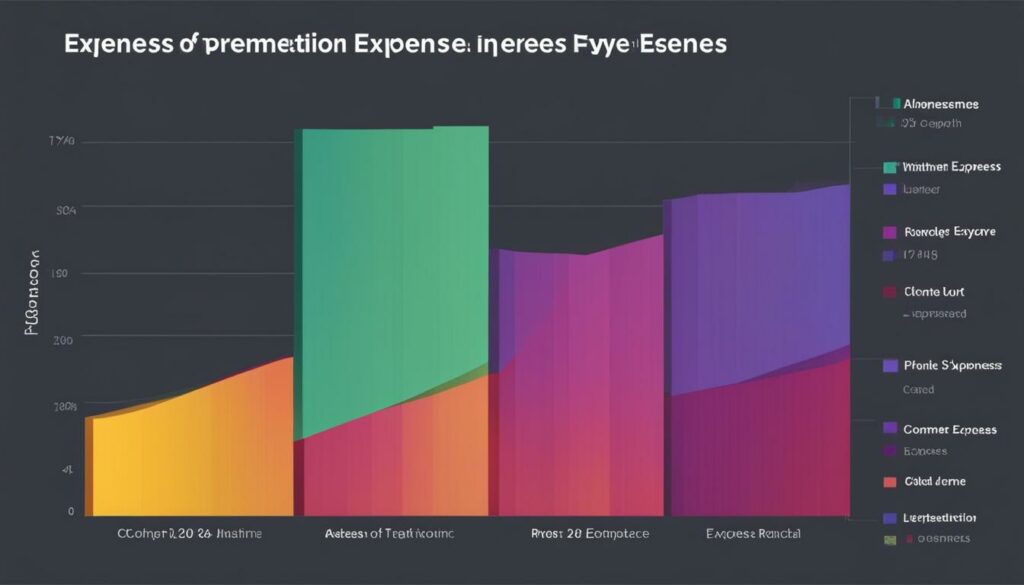Expenses in ecommerce refer to the various costs and fees that online businesses incur in their day-to-day operations. These expenses can include website building and hosting fees, platform payments, permits and licenses, utilities, shipping costs, returns and refunds, equipment and asset maintenance, inventory management, storage costs, marketing and advertising expenses, subscription software services, transactional costs, cybersecurity measures, insurance, and taxes. It is important for ecommerce businesses to carefully manage and optimize their expenses to ensure profitability and sustainability.
Key Takeaways:
- Ecommerce expenses are the costs and fees associated with running an online business.
- These expenses include website fees, shipping costs, marketing expenses, and more.
- Proper expense management is crucial for the profitability and long-term success of an ecommerce business.
- Strategies like budgeting, tracking expenses, and optimizing inventory can help improve expense management.
- Customer behavior, such as returns and refunds, can impact expenses in ecommerce.
The Definition of Expenses in Ecommerce
In the world of ecommerce, expenses are the essential costs that online businesses must bear in order to carry out their regular operations and maintain their digital presence. These expenses encompass a wide range of financial obligations, covering both fixed and variable costs.
Fixed costs, also known as operating expenses, are the consistent expenditures that businesses incur to keep their operations running smoothly. These include expenses such as rent for office or warehouse space, utilities, employee salaries and benefits, and marketing expenses. Fixed costs are an integral part of the day-to-day functioning of an ecommerce business.
On the other hand, variable costs are expenses that fluctuate based on the level of business activity. These expenses depend on factors such as the volume of inventory purchased, marketing campaigns, shipping costs, and customer acquisition. Variable costs are directly linked to the growth and expansion of the ecommerce business.
Moreover, it is important to differentiate between operating expenses and other types of expenses that ecommerce businesses may encounter. Capital expenses, for example, refer to investments made by the business to acquire long-term assets or improve infrastructure. This can include purchasing equipment, upgrading technology systems, or renovating facilities. Capital expenses contribute to the future growth and development of the ecommerce business.
Non-operating expenses, on the other hand, are unrelated to the core activities and day-to-day operations of the business. These can include revenue losses from investments, interest expenses, or one-time charges related to legal matters or non-recurring events.
When managing expenses in ecommerce, it is crucial for business owners to thoroughly understand the different types of costs they may encounter. By examining and categorizing expenses, ecommerce businesses can gain greater insight into their financial structure and make informed decisions regarding cost optimization and resource allocation.

Strategies to Optimize Expenses in Ecommerce
Implementing effective strategies can help ecommerce businesses optimize their expenses and achieve financial stability. Here are some key strategies:
- Budgeting: Creating a comprehensive budget that outlines anticipated expenses and tracks actual spending.
- Financial Tracking Software: Utilizing financial tracking software to monitor expenses and identify areas of cost reduction.
- Inventory Management: Implementing efficient inventory management systems to minimize carrying costs and reduce inventory shrinkage.
- Cost-Effective Marketing: Developing targeted and cost-effective marketing strategies that yield maximum returns on investment.
- Shipping Negotiations: Negotiating bulk deals with shipping carriers to minimize shipping costs.
- Streamlined Returns Process: Streamlining the returns process to minimize costs associated with returns and refunds.
- Subscription Software Services: Investing in subscription software services that optimize accounting, communication, organization, customer service, and social media management.
By adopting these strategies, ecommerce businesses can effectively manage their expenses and pave the way for sustainable growth and profitability.
| Expense Category | Description |
|---|---|
| Operating Expenses | Costs incurred in the day-to-day operations of the business, including rent, payroll, utilities, and marketing expenses. |
| Capital Expenses | Investments made for future growth, such as equipment purchases, technology upgrades, and infrastructure improvements. |
| Non-operating Expenses | Expenses unrelated to the core operations of the business, including interest expenses, legal fees, or one-time charges. |
The Importance of Expenses in Ecommerce
As an ecommerce business owner, understanding the importance of expenses is essential for long-term success and profitability. Effective expense management allows you to analyze your costs, make informed decisions, and optimize your financial planning. By allocating resources effectively and identifying areas for cost reduction, you can enhance your business’s financial health and ensure sustainability.
Expense analysis is a critical component of financial planning in ecommerce. It enables you to evaluate your spending patterns, identify unnecessary costs, and find opportunities for optimization. By tracking and analyzing expenses, you gain insight into your business’s financial performance and can make data-driven decisions to increase profitability.
The Benefits of Expense Management
Expense management offers several notable benefits for ecommerce businesses:
- Cost Reduction: By carefully monitoring and managing expenses, you can identify areas where costs can be reduced without compromising the quality of your products or services. This helps improve your bottom line and boosts profitability.
- Resource Allocation: Effective expense management allows you to allocate your resources efficiently. It enables you to invest in areas that drive growth and success while minimizing unnecessary spending.
- Financial Planning: Analyzing your expenses gives you a comprehensive view of your financial health and allows you to plan for the future. It helps you set realistic goals, establish budgets, and make strategic business decisions.
Strategies for Effective Expense Management
To optimize expense management in ecommerce, consider implementing the following strategies:
- Budgeting: Create a detailed budget that outlines your projected expenses and revenues. Regularly review and adjust your budget as needed.
- Cost Analysis: Conduct a thorough analysis of your expenses to identify areas for cost reduction. Look for opportunities to negotiate better pricing, seek discounts, or explore alternative suppliers.
- Inventory Management: Optimize your inventory management to minimize carrying costs, reduce shrinkage, and avoid excess inventory. Implement effective inventory tracking and forecasting systems.
- Marketing Efficiency: Evaluate the effectiveness of your marketing strategies and campaigns. Focus on strategies that provide a high return on investment and consider reallocating resources from less effective channels.
By implementing these strategies, you can significantly improve expense management in your ecommerce business, boost profitability, and drive sustainable growth.

Effective expense management is crucial for the long-term success of your ecommerce business. It empowers you to optimize costs, make informed decisions, and achieve financial stability. By analyzing and managing your expenses, you can enhance profitability, allocate resources effectively, and ensure sustainable growth in the competitive ecommerce landscape.
Strategies to Improve Expense Management in Ecommerce
To effectively manage expenses in ecommerce, businesses can implement a range of strategies focused on expense optimization, cost reduction, and overall financial efficiency. By adopting these strategies, businesses can maximize their profitability and ensure long-term sustainability in a competitive market.
Budgeting and Regular Expense Tracking
One of the fundamental strategies for expense management is creating a comprehensive budget and regularly tracking expenditures. This allows businesses to identify areas where costs can be reduced and ensure that funds are allocated efficiently. By closely monitoring expenses, businesses can make data-driven decisions and implement necessary cost-cutting measures. Regular expense tracking also enables businesses to identify any unexpected or unnecessary expenses that may arise.
Financial Tracking Software
Utilizing financial tracking software is crucial for efficient expense management. These software solutions provide businesses with real-time visibility into their finances, allowing them to monitor expenses, track revenues, and make informed financial decisions. By leveraging robust financial tracking software, businesses can streamline their expense management processes and improve overall financial control.
Optimizing Inventory Management
Effective inventory management is essential for cost reduction and expense optimization in ecommerce. By implementing inventory management systems, businesses can reduce shrinkage and carrying costs, avoid overstocking or understocking, and improve overall inventory turnover. This not only minimizes unnecessary expenses but also ensures that products are readily available for customers, enhancing the overall shopping experience.
Implementing Cost-Effective Marketing Strategies
Marketing plays a vital role in ecommerce, but it can also be a significant expense. To optimize marketing expenses, businesses should focus on cost-effective strategies such as targeted digital advertising, content marketing, and social media advertising. By identifying the most effective channels and campaigns, businesses can allocate their marketing budget more efficiently and maximize the return on investment.
Negotiating Bulk Deals with Shipping Carriers
Shipping costs are a significant expense for ecommerce businesses. To reduce these expenses, businesses should consider negotiating bulk deals and establishing partnerships with shipping carriers. By leveraging their shipping volumes, businesses can secure discounted rates and reduce their overall shipping expenses. This strategy not only optimizes expenses but also allows businesses to offer competitive shipping rates to their customers.
Streamlined and Efficient Returns Process
Returning products is an inevitable part of ecommerce, and the costs associated with returns can impact expenses. To manage returns effectively and minimize expenses, businesses should focus on offering a streamlined and efficient returns process. By simplifying the returns procedure, providing clear instructions, and offering prepaid shipping labels, businesses can reduce the cost of handling returns and enhance customer satisfaction.
Investing in Subscription Software Services
Subscription software services offer businesses a range of useful tools for expense management, accounting, communication, organization, customer service, and social media management. By investing in these services, businesses can automate processes, improve efficiency, and reduce manual labor, ultimately optimizing both time and financial resources.

Implementing these strategies empowers ecommerce businesses to optimize their expenses, improve financial performance, and achieve long-term success.
Customer Behavior and its Impact on Expenses
Customer behavior plays a crucial role in shaping the expenses of ecommerce businesses. Understanding how customer behavior influences returns and refunds is essential for effective expense management. In this section, we will explore the impact of customer behavior on expenses in ecommerce and discuss strategies to mitigate these costs.
The Rate of Returns in Ecommerce
Ecommerce purchases have a higher return rate compared to brick-and-mortar stores, with approximately 20% of online purchases being returned. This can significantly impact the expenses of ecommerce businesses, as they must bear the costs associated with returns and refunds.
“Approximately 20% of online purchases are returned, highlighting the need for ecommerce businesses to carefully manage their return costs.”
The Importance of Generous Return Policies
Today, online shoppers expect a generous return policy and easy, free returns. Offering such policies is crucial to customer satisfaction and encouraging repeat purchases. However, businesses must consider the expenses associated with these return policies as part of their overall expense management.
Accounting for Return Costs
When managing expenses in ecommerce, it is important for businesses to account for return costs, including restocking and disposal fees. These costs can vary depending on the nature of the products sold and the specific return process. By accurately tracking and analyzing return costs, businesses can better understand their impact on overall expenses and make informed decisions regarding their return policies.
Reducing Returns through Customer Satisfaction
One effective strategy to minimize return expenses is to focus on customer satisfaction. By providing high-quality products, accurate product descriptions, and excellent customer service, businesses can reduce the likelihood of returns and improve customer satisfaction.
“Focusing on customer satisfaction is key to reducing returns and minimizing associated expenses in ecommerce.”
Positive Reviews and Feedback
Positive reviews and feedback from satisfied customers can also contribute to reducing returns. Customers often rely on reviews to make purchasing decisions, and positive feedback can help build trust and confidence in the products being sold. By prioritizing customer satisfaction and encouraging positive reviews, businesses can enhance their reputation and further reduce return expenses.
Strategies to Minimize Return Expenses
Implementing efficient return processes, optimizing product descriptions, providing detailed size charts and product specifications, and offering exceptional customer support are some effective strategies to minimize return expenses. These efforts not only reduce the financial impact of returns but also contribute to improved customer satisfaction and long-term profitability.
Challenges and Considerations in Expense Management for Ecommerce
Expense management in ecommerce presents numerous challenges and considerations that businesses must address to control costs, ensure financial stability, and safeguard their online operations.
One significant challenge is the unpredictable nature of shipping costs. Fluctuations in carrier charges and policy changes can have a direct impact on expenses. To mitigate this challenge, businesses can negotiate bulk deals with shipping carriers and closely monitor changes in shipping regulations to make informed decisions when it comes to shipping costs.
Another crucial consideration is the need for secure online payment processing and cybersecurity measures. Ecommerce businesses must invest in robust cybersecurity solutions to protect customer data, prevent fraud, and ensure secure transactions. By prioritizing cybersecurity, businesses can mitigate the risk of financial loss and reputational damage resulting from cyber attacks.
Additionally, inventory accuracy and shrinkage management are vital expense considerations. Maintaining accurate inventory records is crucial in minimizing carrying costs and reducing the risk of stockouts or overstocking. Implementing efficient inventory management practices, such as regular audits and automated tracking systems, can significantly improve cost control and optimize overall financial performance for ecommerce businesses.
Furthermore, compliance with permits, licenses, and tax regulations is a necessary expense consideration. Ecommerce businesses must ensure they meet all legal and regulatory requirements to avoid penalties and legal issues. This includes obtaining the necessary permits and licenses for operating the business and maintaining accurate tax records to ensure proper financial planning and reporting.
Lastly, ecommerce businesses must have adequate insurance coverage to protect their online operations. Insurance policies tailored to the specific risks associated with online businesses, such as cyber liability insurance and product liability insurance, can provide financial protection in the event of unforeseen circumstances or legal claims.
In light of these expense challenges and considerations, implementing cost control strategies and developing an effective financial planning framework are crucial for the long-term success and sustainability of ecommerce businesses.
FAQ
What are expenses in ecommerce?
Expenses in ecommerce refer to the various costs and fees that online businesses incur in their day-to-day operations. These expenses can include website building and hosting fees, platform payments, permits and licenses, utilities, shipping costs, returns and refunds, equipment and asset maintenance, inventory management, storage costs, marketing and advertising expenses, subscription software services, transactional costs, cybersecurity measures, insurance, and taxes.
What is the definition of expenses in ecommerce?
Expenses in ecommerce are the costs that online businesses must pay for their regular operations. These expenses are necessary for the business to function and can include both fixed costs, such as rent, payroll, and utilities, as well as variable costs, such as inventory, marketing, and shipping. It is important to distinguish between operating expenses, which are incurred in the day-to-day operations of the business, and other types of expenses, such as capital expenses, which are investments made for future growth, and non-operating expenses, which are unrelated to the core operations of the business.
Why are expenses important in ecommerce?
Expenses play a crucial role in the financial management of an ecommerce business. Proper analysis and management of expenses allow businesses to understand their financial health, identify areas for cost optimization, and make informed business decisions. By tracking and analyzing expenses, businesses can identify unnecessary costs, find ways to reduce expenses and increase profitability, and allocate resources effectively. Effective expense management is essential for the long-term sustainability and success of an ecommerce business.
What strategies can be implemented to improve expense management in ecommerce?
To improve expense management in ecommerce, businesses can implement various strategies. These include creating a budget and regularly tracking expenses, using financial tracking software, optimizing inventory management to reduce shrinkage and carrying costs, implementing cost-effective marketing strategies, negotiating bulk deals with shipping carriers, offering a streamlined and efficient returns process, and investing in subscription software services for accounting, communication, organization, customer service, and social media management. By implementing these strategies, businesses can optimize their expenses and improve their overall financial performance.
How does customer behavior impact expenses in ecommerce?
Customer behavior can have a significant impact on expenses in ecommerce. The rate of return for ecommerce purchases is higher than that of brick-and-mortar stores, with approximately 20% of online purchases being returned. A generous return policy and easy, free returns are now expected by online shoppers. Businesses must account for these return costs, including restocking and disposal fees, in their expense management. Additionally, customer satisfaction and positive reviews can help to reduce returns and minimize expenses related to customer complaints and dissatisfaction.
What are the challenges and considerations in expense management for ecommerce?
Expense management in ecommerce can present several challenges and considerations. These include the unpredictable nature of shipping costs, the need for secure online payment processing and cybersecurity measures, the potential impact of policy changes and carrier charges, the necessity of maintaining inventory accuracy and minimizing shrinkage, the requirement for compliance with permits, licenses, and tax regulations, and the need for adequate insurance coverage. Businesses must carefully consider these challenges and implement appropriate strategies to control costs, ensure financial stability, and protect their online operations.
